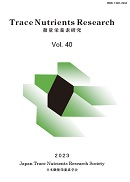最新号
選択された号の論文の21件中1~21を表示しています
- |<
- <
- 1
- >
- >|
原著
-
原稿種別: 原著
2023 年 40 巻 p. 1-5
発行日: 2023/12/15
公開日: 2024/03/29
PDF形式でダウンロード (927K) -
原稿種別: 原著
2023 年 40 巻 p. 6-9
発行日: 2023/12/15
公開日: 2024/03/29
PDF形式でダウンロード (819K) -
原稿種別: 原著
2023 年 40 巻 p. 10-13
発行日: 2023/12/15
公開日: 2024/03/29
PDF形式でダウンロード (796K) -
原稿種別: 原著
2023 年 40 巻 p. 14-19
発行日: 2023/12/15
公開日: 2024/03/29
PDF形式でダウンロード (747K) -
原稿種別: 原著
2023 年 40 巻 p. 20-27
発行日: 2023/12/15
公開日: 2024/03/29
PDF形式でダウンロード (865K) -
2023 年 40 巻 p. 28-33
発行日: 2023年
公開日: 2024/03/29
PDF形式でダウンロード (705K) -
2023 年 40 巻 p. 34-39
発行日: 2023年
公開日: 2024/03/29
PDF形式でダウンロード (985K) -
2023 年 40 巻 p. 40-45
発行日: 2023年
公開日: 2024/03/29
PDF形式でダウンロード (1499K) -
2023 年 40 巻 p. 46-51
発行日: 2023年
公開日: 2024/03/29
PDF形式でダウンロード (1402K) -
2023 年 40 巻 p. 52-57
発行日: 2023年
公開日: 2024/03/29
PDF形式でダウンロード (1298K) -
2023 年 40 巻 p. 58-62
発行日: 2023年
公開日: 2024/03/29
PDF形式でダウンロード (895K) -
2023 年 40 巻 p. 63-69
発行日: 2023年
公開日: 2024/03/29
PDF形式でダウンロード (893K) -
2023 年 40 巻 p. 70-76
発行日: 2023年
公開日: 2024/03/29
PDF形式でダウンロード (1489K) -
2023 年 40 巻 p. 77-80
発行日: 2023年
公開日: 2024/03/29
PDF形式でダウンロード (734K) -
2023 年 40 巻 p. 81-86
発行日: 2023年
公開日: 2024/03/29
PDF形式でダウンロード (693K)
ミニレビュー
-
2023 年 40 巻 p. 87-91
発行日: 2023年
公開日: 2024/03/29
PDF形式でダウンロード (1057K) -
2023 年 40 巻 p. 92-95
発行日: 2023年
公開日: 2024/03/29
PDF形式でダウンロード (1157K) -
2023 年 40 巻 p. 96-102
発行日: 2023年
公開日: 2024/03/29
PDF形式でダウンロード (885K) -
2023 年 40 巻 p. 103-106
発行日: 2023年
公開日: 2024/03/29
PDF形式でダウンロード (738K) -
2023 年 40 巻 p. 107-111
発行日: 2023年
公開日: 2024/03/29
PDF形式でダウンロード (743K) -
2023 年 40 巻 p. 112-116
発行日: 2023年
公開日: 2024/03/29
PDF形式でダウンロード (1525K)
- |<
- <
- 1
- >
- >|
